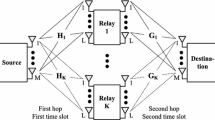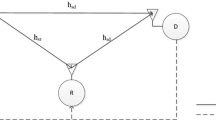Abstract
In conventional digital communication systems, the quality of the received signal does not improve beyond a certain level as the channel quality increases. Such kind of quality saturation effect is caused by the unrecoverable quantization errors produced by source coding. The Hybrid Digital-Analog (HDA) transmission, where the quantization errors are transmitted in an analog mode along with the quantized data in a digital mode, has been recognized as an effective technique to combat the quality saturation effect. In this paper, we introduce HDA transmission in Wireless Relay Networks (WRNs) over Rayleigh slow-fading channels to eliminate the quality saturation effect and achieve graceful improvement for the better channel quality. Our goal is to minimize the end-to-end distortion by optimal power allocation. We note that digital-analog power allocation involved in HDA transmission is coupled with source-relay power allocation in WRNs. Therefore, the joint power allocation problem should be considered. We investigate this problem for two kinds of relays in WRNs, i.e., Amplify-and-Forward (AF) relays and Decode-and-Forward (DF) relays. In the case of AF relays, we find that the joint power problem is concave and thus derive the explicit expressions of the optimal solution. In the case of DF relays, we formulate the joint power allocation problem as a nonlinear fractional programming problem and then propose an efficient algorithm to search the optimal solution. Simulation results show that the proposed joint power allocation schemes outperform existing schemes in terms of end-to-end distortion in both WRNs with AF relays and that with DF relays under various channel conditions.








Similar content being viewed by others
References
Dinkelbach W (1967) On nonlinear fractional programming. Manag Sci 13(7):492–498
Hasna MO, Alouini MS (2004) Optimal power allocation for relayed transmissions over rayleigh-fading channels. IEEE Trans Wirel Commun 3(6):1999–2004
Ho J, Ho PH On optimal power allocation of layered coding in noisy wireless relay networks. In: 2012 15th International Symposium on Wireless Personal Multimedia Communications (WPMC), pp 321–325. IEEE
Huang S, Cai J, Chen H, Zhang H (2015) Transmit power optimization for amplify-and-forward relay networks with reduced overheads. IEEE Trans Veh Technol. In Press
Li L, Zhou X, Xu H, Li GY, Wang D, Soong A (2011) Simplified relay selection and power allocation in cooperative cognitive radio systems. IEEE Trans Wirel Commun 10(1):33–36
Luo J, Blum RS, Cimini LJ, Greenstein LJ, Haimovich AM (2007) Decode-and-forward cooperative diversity with power allocation in wireless networks. IEEE Trans Wirel Commun 6(3):793–799
Prabhakaran VM, Puri R, Ramchandran K (2011) Hybrid digital-analog codes for source-channel broadcast of gaussian sources over gaussian channels. IEEE Trans Inf Theory 57(7):4573–4588
Prabhakaran VM, Puri R, Ramchandran K (2011) Hybrid digital-analog codes for source-channel broadcast of gaussian sources over gaussian channels. IEEE Trans Inf Theory 57(7):4573–4588
Ren S, Letaief KB Minimum sum expected distortion in cooperative networks. In: IEEE International Conference on Communications, 2009. ICC’09. pp 1–5. IEEE
Rungeler M, Bunte J, Vary P (2004) Design and evalution of hybrid digital-analog transmission outperforming purely digital concepts. IEEE Trans Commun 62(11):3983–3996
Skoglund M, Phamdo N, Alajaji F (2006) Hybrid digital-analog source-channel coding for bandwidth compression/expansion. IEEE Trans Inf Theory 52(8):3757–3763
Su W, Sadek AK, Liu KR (2005) Ser performance analysis and optimum power allocation for decode-and-forward cooperation protocol in wireless networks. In: 2005 IEEE Wireless communications and networking conference, vol 2, pp 984–989. IEEE
Su W, Sadek AK, Liu KR (2008) Cooperative communication protocols in wireless networks: performance analysis and optimum power allocation. Wirel Pers Commun 44(2):181–217
Wang Y, Alajaji F, Linder T (2009) Hybrid digital-analog coding with bandwidth compression for gaussian source-channel pairs. IEEE Trans Commun 57(4):997–1012
Yao S, Skoglund M (2009) Hybrid digital-analog relaying for cooperative transmission over slow fading channels. IEEE Trans Inf Theory 55(3):944–951
Yu L, Li H, Li W (2013) Hybrid digital-analog scheme for video transmission over wireless. In: 2013 IEEE international symposium on Circuits and systems (ISCAS), pp 1163–1166. IEEE
Yu L, Li H, Li W (2014) Wireless scalable video coding using a hybrid digital-analog scheme. IEEE Trans Circuits Syst Video Technol 24(2):331–345
Yu L, Li H, Li W (2015) Wireless cooperative video coding using a hybrid digital-analog scheme. IEEE Trans Circuits Syst Video Technol 25(3):436–450
Zhao X., Lu H., CHEN C.W., Wu J (2015) Adaptive hybrid digital-analog video transmission in wireless fading channel. IEEE Trans Circuits Syst Video Technol. In Press
Acknowledgments
This work was supported in part by the National Science Foundation of China (No.61170231, 61390513, 91538203), the National High Technology Research and Development Program of China (863 Program) (No.2014AA01A706).
Author information
Authors and Affiliations
Corresponding author
Additional information
This paper was presented in part at the 2015 IEEE Global Communications Conference (GLOBECOM), San Diego, CA, USA, December 2015.
Rights and permissions
About this article
Cite this article
Lu, H., Kong, X., Jiang, X. et al. Joint Power Allocation in Wireless Relay Networks: the Case of Hybrid Digital-Analog Transmission. Mobile Netw Appl 21, 1013–1023 (2016). https://doi.org/10.1007/s11036-016-0735-3
Published:
Issue Date:
DOI: https://doi.org/10.1007/s11036-016-0735-3




